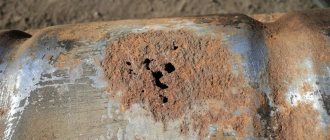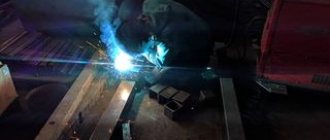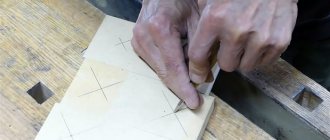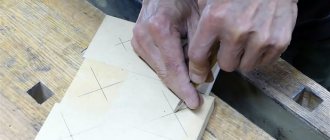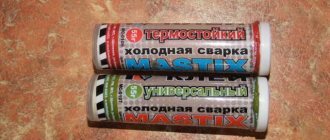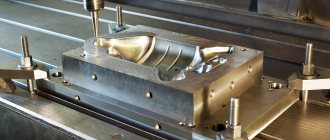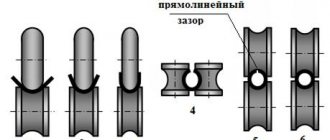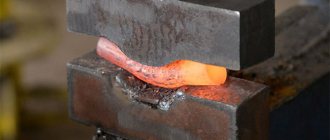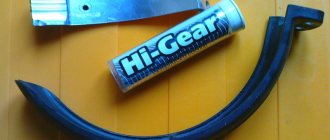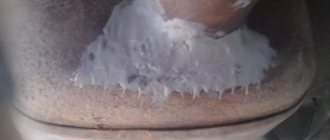Punch for metal
Punch for metal
Metal punches can be divided into light, medium and heavy. This division is arbitrary, but it can facilitate the selection of the material required, depending on the operation of the part, for the production of one or another type of punch. When designing a complex design of stamping products, you need to focus at least on its purpose and operating conditions.
Order punches, send drawings to the Workshop +7 912 291 59 18. High quality, favorable price!
The assessment of production conditions depends on the volume of production (of the programmed part), the thickness of the punch, the material used, physical and mechanical properties, the technological operation, the nature and type of the part and its specific load. If punches are required for small-scale production, then high strength and wear-resistant dies are not required.
When creating such metal products, you must first strive to simplify them and find inexpensive, acceptable and less resistant materials for production.
Working principle of the punch
At the moment of pressing, the punch begins to put pressure on the press washer, and it puts pressure on the workpiece, which is squeezed out through the matrix. Since the part operates under high power and thermal loads, it is made of special, wear-resistant steel. It is highly durable and does not deform under the influence of temperature changes.
In principle, a punch can be called a tool that uses pressure to obtain a workpiece of a certain shape. In stamping production it is one of the most important parts.
If polyurethane is used together with it, then a matrix is made from it, which is the counter part of the stamp.
What materials can the punch be made from?
Most of the stamping equipment, punches and other working parts are made from materials of hard alloys, carbon and alloy steels. With a small production volume of punches, and some of which can be made from inexpensive, low-carbon materials, they must be subject to carburization.
- The choice of material for manufacturing will be directly influenced by the purpose and configuration of the part. If they have a complex geometric shape and are low-tech for heat treatment, then it is necessary to select high-alloy materials for their production, since they will be least susceptible to warping after hardening. These materials include mainly all chromium steels: KhVG, Kh12M, 9KhS, Kh12F1.
- These types of steels can also be used in heavy production work of stamping equipment. Severe types of conditions include those processes that are associated with metal processing of thick sheet metal, as well as all thin sheet material, if the working area has a relatively small cross-section and openwork shape.
- Under strong impact loads, the working area of the punch surface must be made of materials with a high level of viscosity.
The choice of steels used for the production of punches and other dies is influenced by the range of stamped materials. Some of the materials have a huge level of ductility, while some, on the contrary, have high heat resistance and strength properties. Some materials can be easily stamped with tools from simple commonly used steels, while others, for example, high-silicon materials, can only be processed with tools of a high degree of hardness.
Hardness of punches for metal
The hardness property of punching and cutting punches must be extremely high. But if a high degree of hardness during long-term use of the stamp can cause destruction, then it is best to use the degree of hardness for its intended purpose, at which the stamp products will have a lower degree of strength.
The hardness of punches and dies in production equipment for the production of small volume parts up to 1000 units can be HRCe = 40...45, for the production process of parts of at least 5000 units, no less than HRCe = 52...56. The level of hardness of punches, the main task of which is to stamp products in large quantities, will depend on the conditions of production work. In separation stamping equipment, generally, the hardness of the punch is slightly less than the hardness of the die.
Source
DETAILS OF THE DIE AND THEIR HARDNESS
When developing the design of a stamp, it is necessary to at least roughly know the conditions of its operation. Typically, dies are classified into light, medium and heavy. This division is arbitrary, but it facilitates the selection of the appropriate material for the manufacture of a particular stamp part.
The assessment of conditions depends on the scale of production (production program), the physical and mechanical properties of the stamped material and its thickness, the specific load of the working parts and the nature of the technological operation. In single and small-scale production, highly resistant dies are not required. When designing such dies, it is necessary to strive to simplify them and find the cheapest and least resistant materials for working parts.
In most separation dies, the working parts are made of carbon and alloy steels and hard alloys. With a small production program, punches and dies can be made from hardenable, but less resistant steels, and some of the designs can even be made from low-carbon steel with subsequent carburization.
The choice of material is directly affected by the configuration of the part. If the working parts of the die have a complex shape and are not technologically advanced for heat treatment, then high-alloy steels should be chosen, which are less susceptible to warping and have a more durable structure after hardening. Such steels include mainly chromium steels: Kh12F1, Kh12M, 9KhS, KhVG, etc. The same steels are recommended for use under difficult die operating conditions. Severe conditions include processes associated with the processing of thick sheet materials, as well as thin ones if the working parts have an openwork shape and relatively small sections.
Under shock loads, it is necessary to make working parts from steels with high toughness.
The choice of material for the working parts of the stamp is influenced by the range of stamped materials. Some materials have high ductility, others do not, others have increased strength or heat resistance, etc. Some materials can be easily stamped with tools made from conventional recommended steels, others, such as high-silicon steels, can only be processed with carbide working tools.
For the choice of material for punches, dies and other die parts, see [8, p. 411; 4, p. 442 and 9, p. 7].
The hardness of the working parts of the stamp must be extremely high. However, excessive hardness can cause destruction of these parts during the operation of the stamp, so an optimally high hardness should be used, at which the stamp parts have the greatest strength.
The hardness of the matrix and punch in separating dies for small batches of workpieces produced (up to 1000) can be HRCе = 40 ... 45, with a production program of up to 5000 pieces. - not less than HRCe = 52...56. The hardness of steel dies and punches intended for stamping large batches of workpieces depends on operating conditions (Table 5).
Table 5
The influence of operating conditions on the hardness of dies and punches
| Working conditions | Hardness HRC3 | |
| punches | matrices | |
| Lungs | 56 … 60 | 58…62 |
| Heavy | 52…56 | 55…68 |
| During hot stamping | 40…50 | 50…54 |
In separating dies, the hardness of the punch is less than the hardness of the matrix. This is explained by the fact that the punch is, as a rule, a moving working part and strikes when performing a technological operation. Consequently, the punch is more susceptible to chipping than the stationary die. An exception is parts made of metal-ceramic carbide, when the punch and matrix have the same hardness. However, in this case, to eliminate shear loads (transverse), the stamp must be equipped with high-precision guide elements.
The low bending resistance of carbide sometimes does not allow the use of thin punches. In such cases, it is advisable to combine a carbide matrix with a punch made of high-alloy steel (ХВГ, Х12М, 5ХС, etc.). It has been noted that with this option of materials, the durability of the steel punch increases by 5...6 times compared to the usual option, when the matrix and punch are made of steel.
In separating dies, in addition to working parts, the following are subjected to heat treatment: catchers, clamps, stops, knives, and in some cases, holders.
Catchers and clamps work on abrasion, so the hardness of their material must be quite high (HRCe = 50...54), stops that are not associated with making precise dimensions are subjected to heat treatment to hardness HRCe = 40...45. Under more severe operating conditions, their hardness should increase to HRCе=50...54. Knives (stepping, for cutting waste, etc.) must have the hardness of the punches. Holders for punches and dies are subjected to heat treatment when working under difficult conditions: pressing working parts made of hard alloys into them and fastening quick-change tools. For the first case, the hardness of the holder is HRCе = 50...54, and for the second, HRCе = 56...60.
In forming dies (drawing, bending, etc.), the matrix and clamps wear out to a significant extent. The rate of their wear is significantly affected by the speed of movement of the working parts of the press. When working on high-speed presses, these die parts are made from high-quality tool steels with a hardness of HRCe = 56...60. In dies for low-speed presses (no more than 20 strokes per minute), these parts can have a hardness of HRCe = 40...50. However, if the working conditions are difficult (large drawing depth, sharp transitions on the working surface), then the hardness of the material of the parts must be quite high (HRCe = 56...60).
When stamping non-ferrous metals in small-scale production, strict requirements for the hardness of the working parts of the stamps are not imposed. For detailed and specific information about the choice of hardness of the material of the stamp parts, see [11, p. 150; 4 and 8].
When developing the design of a stamp, it is necessary to at least roughly know the conditions of its operation. Typically, dies are classified into light, medium and heavy. This division is arbitrary, but it facilitates the selection of the appropriate material for the manufacture of a particular stamp part.
The assessment of conditions depends on the scale of production (production program), the physical and mechanical properties of the stamped material and its thickness, the specific load of the working parts and the nature of the technological operation. In single and small-scale production, highly resistant dies are not required. When designing such dies, it is necessary to strive to simplify them and find the cheapest and least resistant materials for working parts.
In most separation dies, the working parts are made of carbon and alloy steels and hard alloys. With a small production program, punches and dies can be made from hardenable, but less resistant steels, and some of the designs can even be made from low-carbon steel with subsequent carburization.
The choice of material is directly affected by the configuration of the part. If the working parts of the die have a complex shape and are not technologically advanced for heat treatment, then high-alloy steels should be chosen, which are less susceptible to warping and have a more durable structure after hardening. Such steels include mainly chromium steels: Kh12F1, Kh12M, 9KhS, KhVG, etc. The same steels are recommended for use under difficult die operating conditions. Severe conditions include processes associated with the processing of thick sheet materials, as well as thin ones if the working parts have an openwork shape and relatively small sections.
Under shock loads, it is necessary to make working parts from steels with high toughness.
The choice of material for the working parts of the stamp is influenced by the range of stamped materials. Some materials have high ductility, others do not, others have increased strength or heat resistance, etc. Some materials can be easily stamped with tools made from conventional recommended steels, others, such as high-silicon steels, can only be processed with carbide working tools.
For the choice of material for punches, dies and other die parts, see [8, p. 411; 4, p. 442 and 9, p. 7].
The hardness of the working parts of the stamp must be extremely high. However, excessive hardness can cause destruction of these parts during the operation of the stamp, so an optimally high hardness should be used, at which the stamp parts have the greatest strength.
The hardness of the matrix and punch in separating dies for small batches of workpieces produced (up to 1000) can be HRCе = 40 ... 45, with a production program of up to 5000 pieces. - not less than HRCe = 52...56. The hardness of steel dies and punches intended for stamping large batches of workpieces depends on operating conditions (Table 5).
Table 5
The influence of operating conditions on the hardness of dies and punches
| Working conditions | Hardness HRC3 | |
| punches | matrices | |
| Lungs | 56 … 60 | 58…62 |
| Heavy | 52…56 | 55…68 |
| During hot stamping | 40…50 | 50…54 |
In separating dies, the hardness of the punch is less than the hardness of the matrix. This is explained by the fact that the punch is, as a rule, a moving working part and strikes when performing a technological operation. Consequently, the punch is more susceptible to chipping than the stationary die. An exception is parts made of metal-ceramic carbide, when the punch and matrix have the same hardness. However, in this case, to eliminate shear loads (transverse), the stamp must be equipped with high-precision guide elements.
The low bending resistance of carbide sometimes does not allow the use of thin punches. In such cases, it is advisable to combine a carbide matrix with a punch made of high-alloy steel (ХВГ, Х12М, 5ХС, etc.). It has been noted that with this option of materials, the durability of the steel punch increases by 5...6 times compared to the usual option, when the matrix and punch are made of steel.
In separating dies, in addition to working parts, the following are subjected to heat treatment: catchers, clamps, stops, knives, and in some cases, holders.
Catchers and clamps work on abrasion, so the hardness of their material must be quite high (HRCe = 50...54), stops that are not associated with making precise dimensions are subjected to heat treatment to hardness HRCe = 40...45. Under more severe operating conditions, their hardness should increase to HRCе=50...54. Knives (stepping, for cutting waste, etc.) must have the hardness of the punches. Holders for punches and dies are subjected to heat treatment when working under difficult conditions: pressing working parts made of hard alloys into them and fastening quick-change tools. For the first case, the hardness of the holder is HRCе = 50...54, and for the second, HRCе = 56...60.
In forming dies (drawing, bending, etc.), the matrix and clamps wear out to a significant extent. The rate of their wear is significantly affected by the speed of movement of the working parts of the press. When working on high-speed presses, these die parts are made from high-quality tool steels with a hardness of HRCe = 56...60. In dies for low-speed presses (no more than 20 strokes per minute), these parts can have a hardness of HRCe = 40...50. However, if the working conditions are difficult (large drawing depth, sharp transitions on the working surface), then the hardness of the material of the parts must be quite high (HRCe = 56...60).
When stamping non-ferrous metals in small-scale production, strict requirements for the hardness of the working parts of the stamps are not imposed. For detailed and specific information about the choice of hardness of the material of the stamp parts, see [11, p. 150; 4 and 8].
Method of heat treatment of parts made of HVG steel
The invention relates to the field of metallurgy and can be used in heat treatment of parts that require high dimensional accuracy, high mechanical properties, reliability and durability. The technical result of the invention is a reduction in deformation by more than half, an increase in impact strength and a decrease in its anisotropy compared to known heat treatment methods. The technical result is achieved by using different cooling techniques during hardening in different temperature ranges, especially in the temperature range of martensitic transformations, and a new tempering technique. The new cooling and tempering technique ensures minimal deformation and less anisotropy of the impact strength of HVG steel, which increases the reliability and durability of products, and also speeds up the production process. The invention can be used in precision instrument making and mechanical engineering. 1 salary files, 1 table.
The invention relates to the field of metallurgy and can be used for heat treatment of parts made of HVG steel, which require high dimensional accuracy and high mechanical properties, especially for molds with a hardness of HRSe 49
53, used in precision instrumentation.
There is a known method of hardening parts made of HVG steel, which consists of heating to a temperature of 820-850 o C, holding and cooling in oil at a temperature of 20-50 o C, washing in a hot solution of Na2CO3 in water. After that, tempering is carried out to a given hardness HRСe 49-53 [1]. With this hardening method, the main structural transformations of austenite into martensite occur at low temperatures. Due to a decrease in temperature, the volume of steel decreases, and the transformation of austenite into martensite increases the volume of steel. In addition, cooling to low temperatures of 20-50 o C causes a decrease in the ductility of steel. These reasons increase deformation and change the volume of steel, which sometimes leads to cracks directly during hardening or over time during operation.
The closest to the proposed method is the method of isothermal hardening of complex-shaped parts made of HVG steel, which consists of heating to 830-850 o C, holding and cooling to 160-180 o C, holding followed by cooling to shop temperature. After which the parts are washed from oil in a 3-5% solution, Na2CO3 in water at 80-100 o C and tempered to a given hardness [2].
During heat treatment using this method, a smaller temperature difference is formed due to cooling to an elevated temperature (160-180 o C) and
15-30% martensite. This also does not cause large internal stresses. But subsequent cooling to shop temperature reduces the volume of steel and causes the transformation of retained austenite into martensite, which causes significant internal stresses that lead to unacceptable deformation of thin-walled parts of complex configurations. Therefore, it is not recommended to subject parts of complex configurations to this heat treatment regime.
The technical result achieved when using the proposed method is to reduce deformation, increase impact strength and reduce its anisotropy at a given hardness compared to known heat treatment methods.
To obtain the specified technical result in the proposed method of heat treatment of parts made of HVG steel, including heating for hardening to 830-850 o C, cooling in oil and tempering, cooling of parts is carried out first in oil with a temperature of 90-110 o C, and then at 3 -5% aqueous solution of Na2CO3 with a temperature of 90-100 o C, incubated for 1-60 minutes and heated for tempering at 470-500 o C.
Lesson 4. SHARPENING TOOLS FOR COORDINATE PUNCTION PRESS.
Punch and die
The punch and matrix are technological form-building equipment of industrial machines, which changes the parameters of metal, concrete and other materials: dimensions, surface configuration.
Order punches and dies! Send the drawings to the Workshop. High quality, favorable price!
Punch-die sets are the main working units in the production and processing of metal products. With the help of punches, marking, stamping, pressing, perforating, cutting out metal blanks, casting parts, and bending sheet metal are carried out. These kits are also used in the production of building materials (slag blocks, aerated concrete floor slabs with shaped cavities, etc.). And also bricks, facing and paving tiles.
The matrix is a base (box) into which the workpiece is placed. The matrix sets the parameters of the future part, acts as a response unit of the punch, the profiles coincide.
A punch is a tool that acts as a closing element of the system. It forms the shape of the product from above and works as a press, marking machine, or stamp.
Stamp and punch
In any stamp, the design of this part always coincides with the cutting part of the matrix.
In fact, this part can be called the closing part, creating the upper part of the product. A punch is a small press that is capable of stamping and marking parts. With its help, you can stamp parts of any shape or apply markings, and it can be ordinary or in a mirror image.
mainly used in the metalworking industry , where metal pressing is used and sheet blanks are formed. In the construction industry, aerated concrete blocks with shaped voids are produced using a punch.
Punch and die materials
During production, the tooling undergoes the following impacts:
- High blood pressure;
- High temperature background (during hot processes);
- Cold temperatures (in emergency cases of forced cooling);
- Sudden changes in temperature environment;
- Contact with liquid medium.
Taking into account the listed factors, the matrix and punch for the stamp must be made of material with the following qualities:
- increased strength;
- resistance to wear;
- resistance to corrosion.
In addition, when heated, the material should not change its dimensions significantly - this can lead to damage to the manufactured parts. It is also taken into account that some materials change their properties at elevated temperatures. Thus, alloy steel becomes brittle when exposed to heat, so punches made from it are not used for hot processes.
We design and manufacture final punches1 for cold heading2 splines
Construction: The final punches3 are made prefabricated or one-piece. For landing splines, designs consisting of a punch holder and a punch fastened with a screw or pin are used.
Standards: GOST, JIS, ANSI, DIN, Phillips, PozyDrive, Torx, according to customer drawings and industry standards of enterprises.
Material: steel X12MF, R6M5, BOHLER S390 and similar in properties4. Punches can be made from the above steels without coating or with a hardening coating applied.
| Material | Chemical composition, % | Heat treatment | Impact strength, kJ/m2 | Ultimate compressive strength, MPa | Hardness, HRce |
| X12MF | C(1.45-1.65) Cr(11-12.5) Mo(0.4-0.6) V(0.15-0.3) Si(0.15-0.35) S( up to 0.03) P(up to 0.03) Fe(~85) | hardening 1000-1030°C tempering 400°C | 54 | 750 | 60 |
| R6M5 | C(0.82-0.90) Cr(3.8-4.4) Mo(4.8-5.3) W(5.5-5.6) V(1.7-2.1) Co(up to 0.50) P(up to 0.03) Ni(up to 0.04) Si(up to 0.05) Mn(up to 0.05) S(up to 0.025) Fe(~80) | hardening 1220°C tempering 550°C | 180 | 850 | 64 |
| BOHLER S390 microclean | C(1.60) Cr(4.80) Mo(2.00) V(5.00) W(10.50) Co(8.00) Fe(~70) | hardening 1150-1230°C tempering in 3 stages | 170 | 900 | 69 |
Hardening of working surfaces: We offer the following types of coatings for the working part of the punches:
- TiN (titanium nitride)
- TiCN (titanium carbide nitride)
- TiAlN (titanium aluminum nitride)
There are other types of hardening of working surfaces; a comparative analysis of their effectiveness is given in the table:
| Processing method | The essence of the process | Increased wear resistance |
| Electrical discharge alloying | The treatment is based on the thermal effect of pulsed electrical discharges that occur between the tool electrode and the workpiece placed in a dielectric medium. | 2.5 times |
| Surface heat treatment | The surface layers of the tool are heated above critical points, creating a sharp temperature gradient across the cross section, after which rapid cooling occurs, i.e. the surface layer is completely hardened. | 2-3 times |
| Laser hardening | Pulsed exposure to a light beam characterized by an extremely high energy density, which causes local heating followed by rapid cooling. | 2-4 times |
| Methods of physical deposition (condensation) of wear-resistant coatings | Application of coatings of carbides and nitrides of refractory metals by diffusion methods, deposition from a gaseous environment by ion-plasma and electron-plasma methods. | 2-5 times |
According to the type of forming profile, punches can be:
| Phillips slot | Internal hexagon |
| Straight spline | Twelve-beam slot |
| Square spline | Spline “two-prong fork” |
| Hexagonal slot | One Way Spline |
| Three-wing slot | Torx spline |
| Four wing slot | Other possible forms |
Services: carries out the design of punches for cold heading according to the customer’s technical specifications with subsequent production.
More on the topic:
- GOST 26401-84 Tools for cold heading machines. The punches are final. Design and dimensions
- Dies for cold heading
- Preliminary punch
- Feeding tool for cold heading machines
- Cutting and transport tool
1 Punch is one of the main parts of a set of equipment used in stamping and pressing of materials. During stamping, the punch exerts direct pressure on the material being processed and, depending on its purpose, forms the required profile at the end of the workpiece. During operation, punches are exposed to high force loads. Therefore, punches for cold heading processes are made from high-strength steels with increased hardenability.
2Cold heading is carried out by deforming the original workpiece with shock loads on cold heading automatic presses. In this case, there is a local increase in transverse dimensions with a simultaneous decrease in length. Cold heading is used for shaping the heads of bolts, screws, and rivets for large production programs.
3The shape and dimensions of the final punch depend on the head configuration of the product being upset. The dimensions of the working profile of the punch are assigned according to the product drawing, taking into account wear, manufacturing tolerances and shortfall between the matrix and the punch.
4The materials from which extrusion punches are made must have certain mechanical properties that increase durability. For punches, the key indicators are impact strength, compressive strength and hardness.
Main characteristics of the product
Absolutely any type of stamps has a certain warranty period. The main components of this device are the matrix and the punch, which wear out quite quickly.
These units must be changed regularly because they can last about 5 years without replacement. The equipment of vibration presses and stamping devices has a different design. This is done so that it is possible to carry out various technical operations. For this reason, extensive grinding is performed when producing cylindrical dies. Craftsmen do rough processing of the device, and then clean grinding. The device is sharpened and polished at the last stage of its manufacture.
To make shaped punches , a technological impression is used. The device is hardened in a hot oven for 10 minutes. Next, the final sanding begins. To obtain a product of complex shape, a large amount of specialized equipment is used. It is almost impossible to do without the use of milling and planing machines.
Similar equipment is needed for matrix production. When the molds for the press are made of very high quality, and the punch is equipped with an accurate cut line, the stamp will have a high degree of wear resistance and a long service life. Experts believe that making stamps with your own hands is very difficult. To do this, you need to have a lot of knowledge in the field of metal processing.
Recommended metals for punches and dies
- steel of increased strength, hardenability (degree of hardening - up to hardness 55-65 HRC);
- tool steel, grade 6ХВ2С. The hardness of the punch must have the specified values over its entire height, the hardness of the matrix - at a distance of 5 mm along the working line, at a depth of half the height.
- high-strength wear-resistant steels, resistant to deformation temperatures. The material of the punch is stronger than the material of the manufactured product, the base is not only made of metals, but also of rubber, polyurethane (hardness 98 Shore units). Sometimes easily destructible materials (clay, gypsum) can be used for the base: for example, if you need to cast parts with through openings.
ACCEPTANCE RULES
2.1. Punches, dies, holders, backing tiles and keys are subject to external inspection. From each type of product, samples are selected to check the size, geometric shape and hardness in the amount of 5% of the products from the batch, but not less than 5 pieces. A batch is considered to be the number of products that have gone through the production cycle together and are simultaneously submitted for control.
2.2. If unsatisfactory test results are obtained for at least one of the indicators, a double number of products taken respectively from the same batches is re-tested. The results of repeated tests are final and apply to the entire batch.
Types and types of punches and dies
Types of punches differ in design, which is dictated by technological purpose:
Each type of tool is designed to perform operations; the catalog contains photos of punches of all types.
Punching punch: performs punching, cutting holes in sheet material, separates part of the material, forming an internal closed loop. Can be used for perforating sheet material. Often equipped with a release mechanism to release the cut-out part.
Cutting punch (cotter pin): separates the workpiece from the outer closed contour of the part. The punch of the cutting die, depending on the configuration, can cut out metal at angles from 1 degree, in 1-2 stages. The punch and die are most often used to work with material up to 1.5 mm thick.
Piercing punch for a press: creates holes (through/blind) in the workpiece by displacing metal. It can be solid/hollow, creating holes of small or large (500-800 mm) diameters, respectively.
Forming punch: creates a three-dimensional relief product of a closed contour from a metal sheet, often in one step.
Bending punch: bends metal along a given line, pressing into the workpiece to the required depth, thereby forming a bend.
The punch part can have different shapes: simple geometric (cylinder, hexagon, square, rectangle), or shaped (complex), which is used to create parts with a complex contour.
According to the type of its design, the matrix can be
- Solid matrix: for working with parts of a simple external contour.
- Complex matrix: for processing complexly contoured products.
- Prefabricated matrix: manufactured on high-precision machine equipment using a minimum of manual work. To start working, you just need to quickly and easily press its elements into the holder.
- Composite matrix: consists of several identical modules. It is used in molds with several cavities. Split bases are used if the future product has complex geometry. Most often, simple modules are used.
Depending on the characteristics of the product being manufactured, the punch and matrix can be used as complementary parts of a set, or separately. Thus, the base can be used without a punch if it is necessary to produce a part with a flat sole. In the production of building materials, in some cases its use is also not required: for example, when molding standard bricks, when surface quality is not important. If sheet material is stamped, the work can be carried out without a base module - only a flat base is placed under the workpiece.
Features of dies and punches
In order for the manufactured products to have the proper high quality, the geometric dimensions of the tooling modules must be extremely accurate, match each other, their surface is absolutely smooth, the cut line is even, precise, and the press must be precisely centered. To ensure these indicators, the tool undergoes double grinding (roughing, finishing), polishing, and sharpening. Modules of shaped type are produced by technological imprinting, and complex contour ones are made on milling and planing machine units. Then the equipment is hardened at high (about 780°) temperatures.
In cases where the configuration of the punch is more complex than the matrix, it is first manufactured, and then a base is created based on its impression. Special control is carried out to ensure that the gap between the nodes is maintained. Clearance is maintained through independent processing or mutual adjustment.
If the quality of the set is decent, it will last a long time, will give an accurate cut line, and the parts made on it will not require additional processing.
The punch and matrix in the die are advantageous for their versatility, versatility, and practicality. During operation, such equipment can be easily mounted/dismantled without additional effort, the coatings applied to it are uniformly deposited over the entire surface, and the planetary rotation function is available.
Servicing the equipment is not difficult: it is necessary to systematically clean the surface of metal, concrete and other residues (using scrapers, brushes), rinse with water jet pressure and then dry.
Worn sets are not restored, but are promptly replaced with new ones, since their surface wears out and their dimensions lose the required value and accuracy. A tool made from a material selected for a specific task functions without loss of quality for up to several years (4-6 maximum). Therefore, purchasing equipment with a large margin of safety and service life is more rational than frequent replacement of less durable sets.
Chapter 8 MATERIALS FOR DIES, PRESS MOLDS AND MEASURING INSTRUMENTS
8.1. Materials for stamps and molds
Die tools for cold working must have high surface hardness with sufficient core toughness, wear resistance, high resistance to bending, compression, high thermal conductivity, impact strength, etc.
Cold working dies are similar in many ways; the only difference is in the working tool and the workpiece. As a rule, each stamp includes a stamping block, punches and dies (working tools), pullers, ejectors and other parts.
The die block consists of two parallel plates (lower and upper), capable of moving along guide columns and bushings by the shank using a press slide. Die plates are usually made of mild steel or cast iron. They can be cast or made by cutting.
For columns and bushings that operate under abrasion and withstand significant stresses, including bending, steel 20 is usually used, which is cemented, heat-treated, and then ground and run-in in pairs. In this case, the contacting surfaces of the bushings and columns have hard surfaces that, after lubrication, work well under wear loads, and the core of these parts remains unhardened, viscous, capable of bending, eccentric compression, and fracture.
Steels for the main elements of dies
Data on steels for the main elements of dies and their fastening parts are given in table. 7-14, which take into account the recommendations of mechanical engineering standards.
Table 7. Hammer dies
| Name of hammer dies and their parts | Weight of falling hammer parts in t | steel grade | Hardness HB | |
| working part | supporting part | |||
| Open and closed stamps | 0.63 1.0 | 5ХНМ; 5ХГМ; 5ХНВ; 5HNSV | 388-461 375-444 | No more than 302 |
| 1.6 3.15 | 352-429 341-415 | No more than 285 | ||
| 4.0 6.8 | 321-388 311-341 | No more than 255 | ||
| 10.0 16.0 | 277-311 | |||
| Forged blocks (for inserts) Forged blocks with rough grooves (for inserts) | — — | 45X; 5X NM; 5ХНВ | 321-363 | No more than 285 |
| Cast blocks (for inserts): | 0.63-2.0 | 40HL | 302-352 | No more than 255 |
| a) die inserts for stamping carbon and alloy steels | 0.63-1.0 | 5ХНМ; | 341-401 401-444 | roughing stream finishing stream |
| 1.6-3.15 | 5ХНВ; | 331-388 388-429 | roughing stream finishing stream | |
| 4.0-6.3 | 5ХНСВ; | 321-375 352- 401 | roughing stream finishing stream | |
| St. 6.3 | 5ХГС | 285-331 332-375 | roughing stream finishing stream | |
| 6) inserts for stamping of labor-formable steels and alloys | 0.63-1.0 | 4Х5В2ФС; 4Х5В4ФСМ; 4Х2В5ФМ; 4ХЗВ2Ф2М2; 3Х2В8Ф | 341-401 415-460 | roughing stream finishing stream |
| 1.6-3.15 | 341-401 401-444 | roughing stream finishing stream | ||
| 4,0-6.3 | 331-388 363-401 | roughing stream finishing stream | ||
| St. 6.3 | 311-352 331-375 | roughing stream finishing stream | ||
| c) clamps d) keys e) wedges | — | 45 | 375-429 | |
| 302-321 | ||||
| Insert punches (bosses) for stamping hard-to-deform steels and alloys | 0.63-1.0 1.6-3.15 4.0-6.3 | 4Х5В2ФС 4Х5В4ФСМ 4Х2В5ФМ ЗХ2В8Ф | 388-444 375-415 352-388 | |
| Calibration stamps, straightening solid (without inserts) | 0.63-1.0 1.6-3.15 4.0-6.3 St. 6.3 | 5ХНМ 5ХНВ 5ХНСВ | 429-477 401-444 388-429 341-388 | |
Table 8. Dies of crank hot stamping presses
| Name of strains and parts | Steel grades | Hardness HB | Surface hardening method | |
| working part | supporting part | |||
| Blocks | 40HL; 40L | 302-352 | — | |
| Sedimentary and non-mode inserts | 7X3; 5ХГС | 341-415 | — | |
| Grooved inserts for stamping carbon steels | 5ХНМ; 5ХГС; 5ХНВ; 5HNSV | 341-401 roughing stream 491-444 finishing stream 444-495 calibrating stream | — | |
| Backing plates | 40L; 45 | 375-429 | — | |
| Column guides | 20; 45 | _ | Cementation to a depth of 0.8-1.2 mm. HRC 58-64 (for steel grade 20). Quenching to a depth of 1.0-2.0 mm. HRC 45-50 (for steel grade 45) | |
| Guide bushings | Bronze; Br. OTSS6-6-Ch | — | — | |
| Matrix holders | 45X | 321-388 | — | |
| Small clamps (up to 150 mm wide) | 45X; 45 | 321-363 | ||
| Large clamps (over 150 mm wide) | 40HL; 40L | 255-321 | ||
| Push rods, push rods, upper and lower levers | 45X 40X | 321-388 | ||
| Ejectors | 7X3; 3Х2В8Ф; 5ХГС | 388-461 | ||
| Pushers | 45Х 7X3 | 341-415 | ||
| Pullers | 5ХГС | 363-429 | ||
| Rear, side slats, support washers | 45X; 45 | 341—415 | ||
| Insert lugs (punches) with a diameter of up to 50 mm | 4Х5В2ФС ЗХ2В8Ф | 388-460 | Nitriding to a depth of 0.22-0.3 mm. НV 750—1000 or electric spark hardening | |
| Insert lugs (punches) with a diameter of over 50 mm | 5ХНМ 6ХНВ 5Х NSV | 363-429 | ||
| Dies for extrusion stamping of carbon alloy steels | 5XНB 4Х8В2 4Х5В2ФС ЗХ2В8Ф | 415-460 | Nitriding to a depth of 0.22-0.3 mm. HV 750-1000 or spark hardening | |
| Inserts for stamping forgings of complex shapes, heating up to 620-650°C | 4Х2В5ФМ 3Х2В8Ф | 341-401 roughing stream 415-444 finishing stream 444-477 calibrating stream | — | |
| Dies for stamping forgings by extrusion from hard-to-deform steels, heated to 500° C | 4Х5В2ФС 4Х8В2 | 444-477 | Nitriding to a depth of 0.22-0.3 mm. HV 750-1000 | |
| Dies for stamping forgings by extrusion from hard-to-deform alloys, heated to 650° C | 4Х3В2Ф2М2 4Х2В5ФМ 3Х2В8Ф | 444-477 | Nitriding to a depth of 0.22-0.3 mm. HV 750—1000 | |
| Punches for extrusion stamping of forgings | 4Х8В2ФС 4Х5В4ФСМ 3Х2В8Ф 5ВХ NM | 388-111 | 302-363 | Nitriding to a depth of 0.22-0.3 mm. НV 750—1000 or electric spark hardening |
Table 9. Dies for horizontal forging machines
| Name of dies and their parts | steel grade | Hardness HB | Surface hardening method | |
| working part | supporting part | |||
| Blocks of matrices (with grooves without inserts) | 7X3 5ХНВ | 321-444 | — | |
| Matrix blocks (for inserts) | 45 45 X | 285-321 | — | |
| Punch blocks (punch holders) | 45X | 311-388 | 207-229 | — |
| Clamping, pinch, molding inserts | 7X3; 8X3 5ХГС 5ХНВ 5ХНМ | 363- | 415 | |
| Stitched, edged, perforated inserts | 7X3; 8X3; 5ХНВ; 4Х8В | 388-444 | Shot blasting for riveting | |
| Inserts for stamping hard-to-deform alloys | 4Х5В2ФС 3Х2В8Ф | 415—477 | Nitriding to a depth of 0.22-0.3 mm, NU 750-1000 or electric spark hardening of working surfaces | |
| Small and medium type set punches | 7X3 5ХГС | 363-415 | 321-363 | |
| Large typesetting punches | 352-388 | |||
| Forming punches small and medium | 8X3 5ХНВ 5ХНМ | 363-415 | 321-363 | Electrospark hardening of working surfaces |
| Large molding punches | 341-388 | |||
| Edged punches | 8X3 4Х8В2 | 388-444 | ||
| Pushing punches | 45 | 363-415 | ||
| Piercing punches | 4Х5В2ФС 4Х8В2 3Х2В8Ф | 363-415 | 302-341 | Nitriding to a depth of 0.22-0.3 mm, HV 750-1000 or electric spark hardening |
| Punches for stamping hard-to-deform steels and alloys | 4Х5В2ФС 3Х2В8Ф | 388-444 | ||
Table 10. Dies for screw friction presses
| Name of dies and their parts | steel grade | Hardness HB | Surface hardening method | |
| working part | supporting part | |||
| Blocks for inserts | 45; 40L | 375-429 | — | |
| Dies with locks or guide columns | 5ХНМ 5ХНВ | 375-460 | Shot peening | |
| Column guides | 20 | _ | Cementation to a depth of 0.8-1.2 mm, HRC 58-62 | |
| Guide bushings | Cementation to a depth of 0.8-1.2 mm, HRC, 58-62 | |||
| Punch and ejector holders | 35X GSA; 45X | 375-429 | — | |
| Matrix holders | ||||
| Clips | ||||
| Upper and lower mounting plates | 45 45Х | 375-429 | — | |
| Split rings | ||||
| Shanks Clamps | 321-363 | |||
| Pushers | 45X | 341-388 | ||
| Ejectors | 4Х5В2ФС 3Х2В8Ф | 388-477 | ||
| Gaskets, backing plates | U7A 45X | 429-495 | ||
| Inserts for stamping carbon and alloy steels | 5ХГС; 5ХНВ; 5ХНСВ; 5ХНМ | 341-401 rough stream 415-444 finishing stream | ||
| Inserts for stamping forgings of complex shapes from carbon steels, heating up to 620-650° C | 4Х2В5ФМ 5ХНМ 4Х8В2 | 341-401 rough stream 415-444 finishing stream | ||
| Inserts for stamping forgings from ore-deformable steels and alloys | 4Х5В2ФС 3Х2В8Ф | |||
| Dies for stamping of dies from hard-to-deform alloys by extrusion | 4Х5В2ФС 3Х2В8Ф | 429-477 | Nitriding to a depth of 0.22-0.3 mm. HV | |
| The same when heating the matrix to 400-500°C is required | 4Х3В2М2Ф2 | |||
| Bolt landing dies | 7X3; 8X3; 5ХНВ; 5ХНМ | 363-429 | — | |
| Piercing punches for stamping carbon alloy and hard-to-deform steels and alloys | 4Х5В2ФС 4Х8В2 3Х2В8Ф | 388-429 | Nitriding to a depth of 0.22-0.3 mm. HV 750-1000 or electro-spark hardening | |
| Punches for landing bolts | 7X3; 8X3; 5ХГС | 363-415 | — | |
Table 11. Dies for horizontal bending machines (bulldozers)
| Name of stamps and their parts | steel grade | Hardness HB | |
| working part | supporting part | ||
| Blocks | 40L | 302-352 | |
| Matrix inserts | 7X3; 8X3; 5ХГС | 388-444 | |
| Clamps | 45; 40; L | 302-352 | |
| Guide strips | 45X; 45 | 352-388 | |
| Punches | 7X3; 8X3; 5ХГС | 368-429 | 302-352 |
| Punch inserts | 388-444 | ||
Table 12. Dies for forging rolls
| Name of stamps and their parts | steel grade | Hardness of the working part NV | Surface hardening method |
| Clamps, dowels and bolts | 45 | 311-352 | — |
| Forming, stamping, finishing dies for stamping carbon steels | 5ХНМ; 5ХН В; 5ХГС | 388-460 | Shot peening or electric spark hardening of working surfaces |
| Forming and stamping dies for stamping hard-to-deform steels | 4 Х5В2ФС 3Х2В8Ф | 401-477 | |
| Dies for rough stamping of carbon steels | 40HL; high-strength cast iron HF 60-2 | 352-415 | — |
Table 13. Cutting, perforating and straightening dies
| Die parts | steel grade | Hardness HB |
| Top and bottom plates | 30L-I; 40L-1 | ≤255 |
| Hot trim matrices | 8X3 | 363-415 |
| » cold cut | 8HF; 9HF; X12M | 444-514 |
| Hot Cutting Punches | 7X3; 8X3 | 363-415 |
| Cold trimming | 8HF; 9HF | 444-514 |
| Stitching matrices | U10A;U10 | 56-58 HRL |
| Piercing punches | Х12М;Х12Ф1 | 56-60 HRC |
| Hot straightening tool | 8X3 | 363-415 |
| » cold | X12M; Х12Ф1 | 56-60 HRC |
| Transitional punch holders | 45 | ≤217 |
| Linings for punches and dies | 45 | 363-415 |
| Ejectors | 40X | 321-363 |
| Pullers and bolts for them | 45 | 285-321 |
| Spacer sleeves for pullers | Art. 3 | — |
| Tacks | 45 | 285-321 |
Table 14. Stamps for calibration (minting)
| Die parts | steel grade | Hardness |
| Blocks (top and bottom plates) | 45; 45L | HB 302-363 |
| Plates for planar calibration | U10A; X12M | HRC 51-58 |
| Calibration plates (matrices) for volumetric calibration | X12M; X12F1; F | HRC 56-60 |
| Same for hot calibration | 4Х8В2; 3Х2В8Ф | HRC 52-58НВ 302-363 |
| Intermediate plates | 45 | — |

